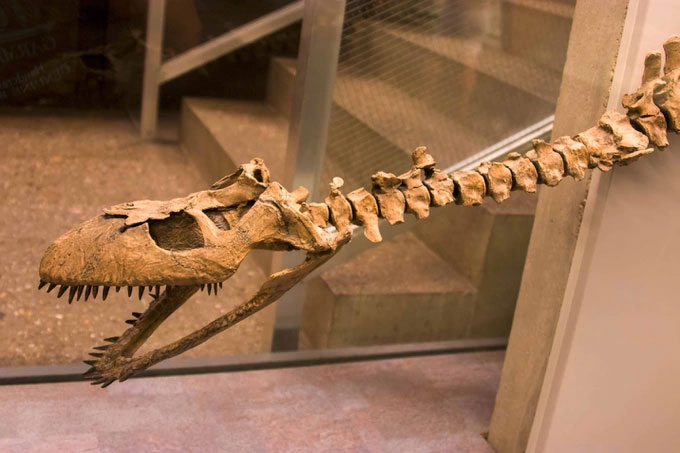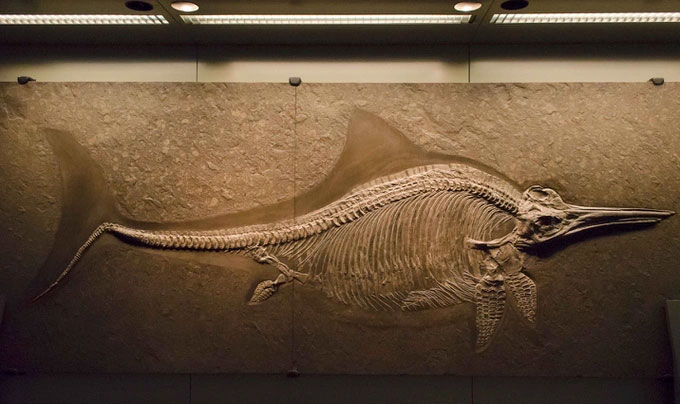Plesiosaurs are a species of marine reptiles with characteristics unlike any known animals today, and their mode of movement remains a mystery that challenges science.
Plesiosaurs were large carnivorous reptiles that lived during the Mesozoic Era, from 251 to 65.5 million years ago, disappearing at the same time as the dinosaurs.
According to a recent study conducted by Dr. Anna Krahl from Eberhard Karls University (Germany), plesiosaurs had a penchant for “flying” underwater!

Reconstruction of Plesiosaurs with an endless long neck (Photo: Dotted Yeti).
Plesiosaurs had some of the most extreme necks ever evolved, potentially reaching lengths of 7 meters composed of 76 vertebrae, with short tails and four “flippers” resembling paddles. However, such an extremely long neck seems difficult for aquatic creatures like plesiosaurs to evolve, as it could hinder their swimming ability.
Paleontologist Peggy Vincent, who is responsible for research at the French National Centre for Scientific Research (CNRS), acknowledges a weakness in plesiosaurs.
She stated: “Their morphology does not correspond to modern animals. They have a very long neck and a barrel-shaped body connected to four paddles for swimming and a relatively short tail.”
The atypical shape of plesiosaurs has sparked numerous hypotheses about their means of movement. Did they use their paddles to swim like an otter? This scientific debate has lasted over a century, and Anna Krahl’s research may provide valuable answers.
Anna Krahl has described in detail how plesiosaurs swam, examining a skeleton found in the Oxford Clay Formation in southeastern England. This specimen belonged to Cryptoclidus—a genus of plesiosaurs ranging from 2 to 3 meters in length.

Fossil of Cryptoclidus displayed at the Naturmuseum Senckenberg in Frankfurt, Germany (Photo: Danny Ye).
The plesiosaur species disappeared at the end of the Late Jurassic period, approximately 145 million years ago. To uncover the secrets of Cryptoclidus, Anna Krahl utilized CT scanning technology on its skeleton to create 3D models, marking the first step toward reconstructing the muscles of this marine reptile.
The paleontologist explained: “The goal of scientists is to determine which muscles of the animal were the most active.”
However, since no extant species resembles plesiosaurs, Anna Krahl and her team hypothesized about the junction between the skeleton and muscles. The author then began simulation work, which revealed the significant role of the extensor and flexor muscles associated with the paddles.
In other words, Cryptoclidus twisted its flippers from top to bottom, similar to a bird. Underwater, such a mechanism generates thrust around the flippers, allowing the creature to propel itself, akin to the swimming technique of sea turtles.
The debate regarding the movement of plesiosaurs is far from over. There is nothing to prevent the possibility that Cryptoclidus could move using its paddles.
“This movement could also occur in the tail or with paddles extended by cartilaginous regions,” Peggy Vincent stated: “These soft tissues can only be seen in cases of special preservation of skeletons, and such fossils have been found in ichthyosaurs, another group of marine reptiles.”

Ichthyosaur skeleton at the Natural History Museum in Vienna, Austria. (Photo: Faviel Raven).
This allows paleontologists to confirm the existence of a thick layer of fat around their bodies as well as in their dorsal fins. Perhaps it would be similar for Cryptoclidus? The answer will depend on future discoveries from excavation sites.
In addition to soft tissue remnants, another way to describe the movement of Cryptoclidus may come from the internal structure of its bones, which retain traces of the animal’s lifestyle. However, achieving this requires powerful scanning technology.
“X-rays must be able to penetrate the fossil, a mineralized object, to provide maximum detail about the internal structure of the bones. This requires high-performance machinery, lengthy analysis times, and specialized labor,” the paleontologist remarked.


















































